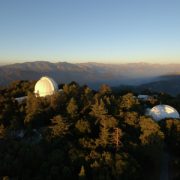Georgia State University and ALPAO sign agreement for adaptive optics upgrade on the world’s largest optical interferometer array
Georgia State University’s Center for High Angular Resolution Astronomy (CHARA) and ALPAO will develop new deformable mirrors and improve the sensitivity of the interferometric telescopes on Mount Wilson, Calif. ALPAO will develop and manufacture six deformable mirrors, each composed of 69 actuators to deform a plane mirror membrane. These deformable mirrors represent state-of-the-art instrumentation to correct for the effect of atmospheric turbulence. The goal of this technique, known as adaptive optics, is to observe stars and their surroundings as clearly as they would appear in space.
“We are delighted to begin this new stage in CHARA’s scientific mission with deformable mirrors from ALPAO,” said CHARA Array Director Theo Ten Brummelaar. “Investigators around the world are now planning new programs with the adaptive optics system that will reveal some of the smallest objects in the sky ever measured.”
This work will complete the first major facility upgrade of the CHARA Array since its initial construction. Theo Ten Brummelaar and collaborators from Georgia State have carefully considered the most effective approaches to enhance the sensitivity of the instrument. The main goal of this work, funded by the U.S. National Science Foundation, is to add deformable mirrors to each of the six 1-meter telescopes, completing the development and implementation of fast adaptive optics capabilities at each telescope.
To simplify the telescope upgrade, the size of the deformable mirror will match the corresponding flat mirror now used on the six CHARA telescopes. The optical surface will form an ellipse measuring 177 x 125 mm (about 7 x 5 inches). Computer control of the actuators will push the surface into a shape that compensates for turbulence in Earth’s atmosphere.
Together, these modifications should allow the telescopes to measure stars three times fainter than now possible. The new system will increase the number of nights with high-quality data by about a factor of three in the summer and five in the winter, with much faster observation times. New important areas of study will include the study of high-interest targets, such as dusty debris disks around young stars and accretion disks and gas flows around newborn stars.
“ALPAO is proud to work with CHARA, the world’s highest angular resolution telescope at near-infrared wavelengths,” said Vincent Hardy, sales manager of ALPAO. “This contract will push us to develop six specific deformable mirrors with a precise elliptical surface. All of our team is very excited to be a part of this project for the future of the interferometric telescope and the development of astronomical science.”




Leave a Reply
Want to join the discussion?Feel free to contribute!